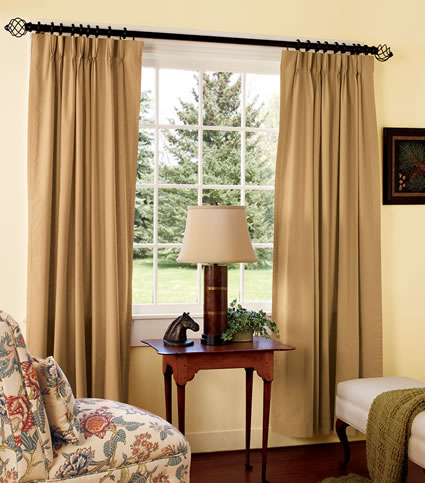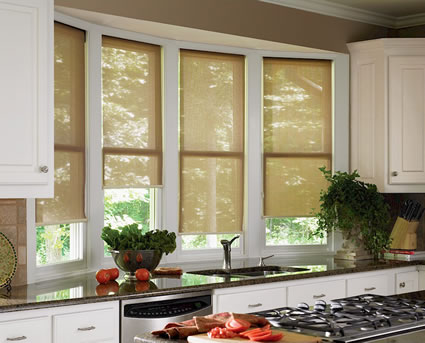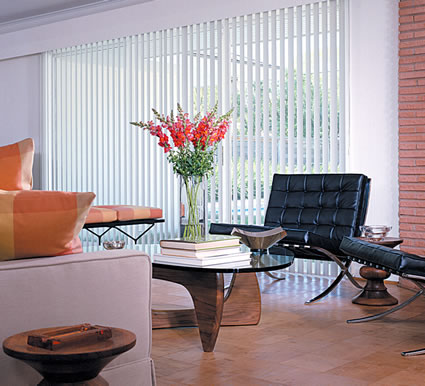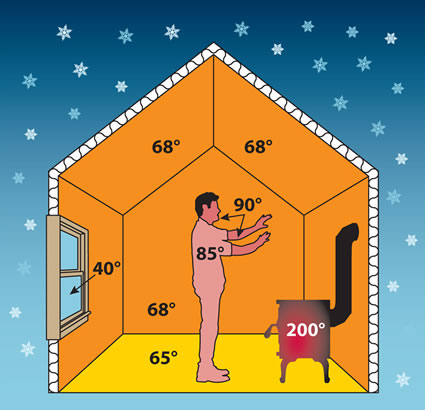Roman shade
This article provides some detail on roman shades, but also drapes, curtains, and other types of shades.
Fabric and color selection have a big impact on several visual and solar performance attributes.
Roman shades can be automated (motors, sensors, remote controls). For more details on automation, see our window covering automation fact sheet.
Description
Conventional interior window coverings such as curtains, drapes, roller blinds, and venetian blinds are used primarily to control light transmission into a home. All come in a wide variety of materials, weaves, fabrics, and colors. They are popular for their low cost, high level of user control, privacy, aesthetics, and comfort. Their primary drawbacks are that they must be deployed to save energy, they block outdoor views when deployed, and they save only a modest amount of energy.
Curtains and Drapes
Curtains and drapes are the simplest, most common window treatments and are most associated with interior aesthetics. They are fabric interior attachments that are either sized to fit the window (curtains) or to reach all the way to the floor (drapes). Usually installed for privacy, curtains and drapes also offer some energy and comfort benefits.

Floor-length, thermally-lined drapes offer the best thermal performance of the conventional treatments, but this comes at the expense of adjustability, view, and daylighting.
Photo: Country Curtains
Roller Shades
Roll-down shades (also called roller shades or roller blinds) fit inside the window casing next to the window sash and are available in a wide variety of fabrics and weaves. The least expensive and simplest are typically opaque and are usually installed to darken rooms and provide full privacy. Roller shades offer modest energy benefits by providing a small amount of insulation (less than fabric curtains), trapping air, and blocking sunlight.
Louvered (Venetian) blinds
Louvered blinds are specialized window blinds that enable a greater degree of light and view control than any other conventional interior window treatment. Their main benefits are reduced glare and solar heat gain. Horizontal slats or louvers are typically connected with cloth tape or cord running through a slot near the end of each slat; these are commonly called venetian blinds. The connectors allow the venetian blind to be raised so that the slats stack tightly together at the top of the window. Another control allows the slats on the fully or partially extended blind to be tilted so that more or less light comes through. The slats can be tilted almost vertically to block most of the sunlight or left fully open (slats parallel to the floor) to allow maximum light transmission. Some venetian blinds can be tilted to direct more light onto the ceiling, extending daylight penetration into a room.

Louvered blinds are in many ways the opposite of conventional heavy, floor-length drapes; superior adjustability, view, glare control, and daylighting properties but very modest thermal performance.
Photo: Hunter Douglas
In addition to horizontal blinds, vertical blinds are available and most commonly used on terrace or sliding-glass doors. They open and close with pull cords, much like drapes. As with horizontal venetian blinds, their greatest benefit is solar control.
Conventional shades, blinds, and drapes can be made more versatile with tracks, sensors, and small, quiet, motors. The operability of conventional shades, curtains, and blinds is both an advantage and a drawback; they not only CAN be adjusted, but they MUST be adjusted to provide the most energy benefit.
Specialty Shades
Roman, pleated, and sheer shades offer unique combinations of aesthetics and function. Each can be selected for a huge range of configurations, colors, fabric type, and weight. Roman shades are often made of heavier fabric to feature privacy and thermal performance. Pleated shades are simpler and more economical versions of cellular shades with an extensive range of fabric selections. Sheer shades offer a wide range of aesthetics with a focus on softened view and glare control.
Overall Thermal Performance
The insulating value of all three conventional interior window treatments is modest and they only provide this benefit when fully deployed. Heavier drapes and curtains provide slightly better performance than the shades and blinds. Normally, the added thermal insulation effect of these window coverings is not greater than R-1. When interior blinds, curtains or drapes are closed in cold weather, they provide a warmer surface between the home occupant and the window glass, so an occupant’s skin radiates less heat and therefore he or she is less likely to feel cold than when windows are uncovered. Windows, particularly low-performance single-glazed and simple double-glazed products, are cold to the touch in winter, or, in technical terms, they have a low mean radiant temperature (MRT, see page 1). As a result, a room with a lot of windows will feel uncomfortably chilly to an occupant. Interior blinds, curtains or drapes raise the MRT of a room, improving comfort.
In cooling-dominated climates during warm months, curtains and drapes can block unwanted heat from the sun (solar heat gain) from coming directly into the space. Window coverings with light-colored backing can, in addition, reflect sunlight back out through the window, further reducing solar heat gain. The effectiveness of window coverings in blocking solar heat gain depends on the thermal performance of the windows; curtains and drapes have greater impact if the windows have standard clear glass. With newer “low-solar gain” low-emissivity coatings, there is less solar gain reaching the interior side of the window for the window coverings to block.
In cooling-dominated climates or the summer months of any climate, conventional window treatments can reduce solar heat gain by anywhere from 20% to 60%, depending on the color and openness of the fabric or material.
Key Benefits
- Minimal cost
- High level of user control
- Effective blocking of direct solar gain and glare
- Privacy
Key Drawbacks
- When closed or drawn, block views of outdoors
- Even when open, may block a significant portion of view (louvered blinds)
Aesthetics
- Wide range of aesthetic options
- Relatively unobtrusive when raised (roller shades and louvered blinds)
Tips/Cautions
- Consider other window retrofits that deliver greater energy savings, or combine with another retrofit option for maximum benefit.
- The tighter curtains and drapes fit to the window sill or floor, the better they will reduce heat loss (by creating a dead-air space).
- Conventional window treatments that lower the interior surface temperature of windows during cold conditions may increase condensation potential.
- Energy performance of curtains and drapes can be improved by using Velcro tabs to tightly hold edges to window or door jambs.
- The impact of shades, blinds, or curtains on reducing solar heat gain is not as significant if the windows are low-e and double-paned because the windows will capture much of the energy savings.

The range of materials, cost, and performance properties for conventional window treatments yields nearly infinite combinations, yet each comes with some sacrifice in overall or specific performance.
Photo: Hunter Douglas

Interior louvered shutters are yet another window covering, which adds privacy and both light and solar control.
Photo: Southern Tradition Window Fashions
When To Consider
- Economy is paramount.
- Privacy or aesthetics are driving interests.
- There are situations when a room needs to be darkened.
- Direct solar gain or glare need to be controlled.
- Climate is mild and more expensive but higher-performance window treatments cannot be justified.
When to consider this retrofit—Ownership
| x | Homeowner |
| x | Apartment Renter - Long Term |
| x | Apartment Renter - Short Term |
| x | Live in a Condo |
| x | Live in a Historical District |
When to consider this retrofit—Window conditions
| x | Existing window single-glazed |
| x | Existing window double-glazed, no low-e* |
| x | Existing window double-glazed with low-e |
* low-emissivity coating
Recommended Installer
| x | Do it Yourself |
| Contractor | |
| x | Manufacturer or supplier |
Complementary Options
- Exterior storm windows
- Interior window panels
- Window films
- Awnings
- Air sealing
Operation
| x | Motorized |
| x | Sensor |
| x | Manual |
Considerations
| 1 | 2 | 3 | 4 | 5 | |
| Ease of Installation (low = easier) |
x | x | |||
| Availability (low = more available) |
x | x | |||
| Cost (low = lower cost) |
x | x |
Average Total Cost for 30- by 60-inch window
| Heavy drapes | $75 |
| Louvered blind | $30 |
| Roller shade | $55 |
Digging Deeper
Calculators/Energy Modeling
| RESFEN | |
| x | EnergyPlus-based tools |
| x | WINDOW 6 |
| Other |
References
“Guidelines for Effective Residential Solar Shading Devices,” Laouadi, NRC

Best suited for the way in which patio doors and slider windows operate, vertical blinds provide much the same versatility as horizontal louvered blinds.
Photo: Hunter Douglas
Terminology

Mean radiant temperature (MRT) is roughly the average temperature of all the objects or surfaces in a space. The temperature contribution of each individual surface is weighted by its area, spatial relationship, and temperature difference from the skin temperature of a person in the space. An MRT that is warmer than the skin temperature of a person will cause the person to feel warmer, and an MRT that is colder than the skin temperature of a person in the room will cause that person to feel colder. MRT and air temperature are the two most important factors in assessing thermal comfort.
